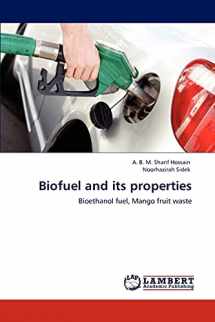
Biofuel and its properties: Bioethanol fuel, Mango fruit waste
ISBN-13:
9783847321293
ISBN-10:
3847321293
Author:
A. B. M. Sharif Hossain, Noorhazirah Sidek
Publication date:
2011
Publisher:
LAP LAMBERT Academic Publishing
Format:
Paperback
144 pages
FREE US shipping
Book details
ISBN-13:
9783847321293
ISBN-10:
3847321293
Author:
A. B. M. Sharif Hossain, Noorhazirah Sidek
Publication date:
2011
Publisher:
LAP LAMBERT Academic Publishing
Format:
Paperback
144 pages
Summary
Biofuel and its properties: Bioethanol fuel, Mango fruit waste (ISBN-13: 9783847321293 and ISBN-10: 3847321293), written by authors
A. B. M. Sharif Hossain, Noorhazirah Sidek, was published by LAP LAMBERT Academic Publishing in 2011.
With an overall rating of 4.1 stars, it's a notable title among other
books. You can easily purchase or rent Biofuel and its properties: Bioethanol fuel, Mango fruit waste (Paperback) from BooksRun,
along with many other new and used
books
and textbooks.
And, if you're looking to sell your copy, our current buyback offer is $0.3.
Description
The exploration of biomass fuels encourages the reduction of world atmosphere pollution and global warming. In addition, the depletion of nonrenewable energy sources such as fossil fuels induces the developing technologies to harness new and renewable energy sources. Abundant of fruits waste can be reused for the bioethanol production. Hence, it can reduce pollution and waste material, thus helps in waste disposal management. In this research, nine parameters were studied that could affect the bioethanol production from mango waste. It was found that the bioethanol production was the highest at temperature of 30 0C and pH 5. Similarly, the highest ethanol concentration was obtained when 3 g/l of yeast used for fermentation. S. cerevisiae yeast was recognized as the best ethanol-producing strain. The bioethanol concentration was highest when the mango mash was hydrolyzed with pectinase enzyme, followed by hydrolysis using cellulase enzyme. It was found that the content of metal elements and viscosity in the bioethanol were under ASTM standard. Therefore, the bioethanol produced from mango waste was suitable to be used as engine fuel and environmetl pollution can be reduced.


We would LOVE it if you could help us and other readers by reviewing the book
Book review

Congratulations! We have received your book review.
{user}
{createdAt}
by {truncated_author}


